
Dan Maloney 2:51 PM
Gonna get started in about 10 minutes, folks
|

Athsara Fernando 2:52 PM
:)
|

Mark J Hughes 2:53 PM
Woohoo! Remind me Dan -- what comes after Part-D, but before Part-F?
|
|
Eugene 2:55 PM
Do we just join here and enjoy the ride? Sorry I'm new too this
|

Mark J Hughes 2:56 PM
@Eugene Yeah -- hang out -- ask questions once the presenter gets here.
|

Mark J Hughes 2:56 PM
You can just start asking now too if you want. Maybe a lurker knows the answer.
|
|
Eugene 2:57 PM
Ok. I'm on my phone, so will the media just play...I guess let me wait, feeling stupid haha
|

Mark J Hughes 2:58 PM
Oh - yeah, no, there's no media. It's all text based
|

Mark J Hughes 2:58 PM
It's an actual Chat.
|
|
Eugene 2:58 PM
AAA..okay cool
|

Mark J Hughes 2:58 PM
Not a webinar they're calling a chat
|

Richard Stanley 2:58 PM
Hi folks. I'm curious about what sats are transmitting in k-band. I think ESA Euclid is doing so, but I'm wonder about others.
|

Mark J Hughes 2:58 PM
Think of it as an AMA
|

Mark J Hughes 2:59 PM
@Richard Stanley Did you go to CSUF?
|
|
Eugene 2:59 PM
Gotha
|

Richard Stanley 2:59 PM
@Mark J Hughes Nope. Don't know what that stands for :)
|

Mark J Hughes 2:59 PM
California State University -- at Fullerton.
|

Mark J Hughes 3:00 PM
'twas a different Richard Stanley then :)
|

Dan Maloney 3:00 PM
OK folks, here we go. I'm Dan and I'm the mod today along with Dusan as we welcome Scott Tilley to the Hack Chat. Today we're going to be turning our eyes and ears upward in the search for satellites
|
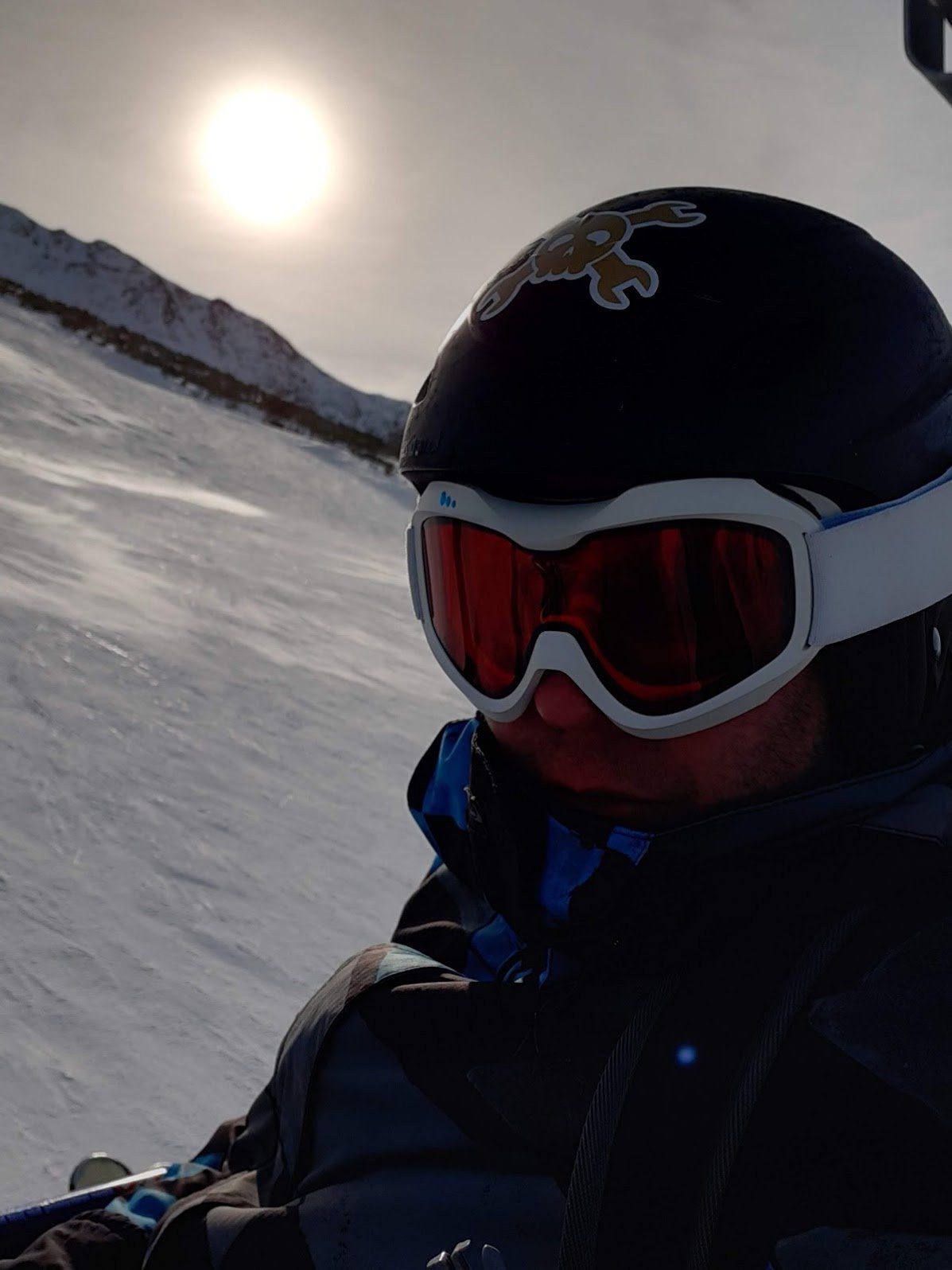
Dusan Petrovic 3:00 PM
Hello and welcome!
|

Scott Tilley 3:01 PM
Thanks for the invitation Dan.
|

Dan Maloney 3:01 PM
Hi Scott! Welcome to the Hack Chat! Care to kick us off with a little about how you got into satellite hunting?
|

Scott Tilley 3:01 PM
Here's some boiler plate on my general background.
|

Scott Tilley 3:01 PM
Scott Tilley, AScT – Is an amateur radio astronomer with an interest in tracking spacecraft in low Earth
orbit (LEO) into deep space. He has over 10 years of experience tracking various objects in space
using optical, radio position and Doppler techniques on various radio bands from VHF to X-Band.
Scott has built and maintains the S-band sensors to be used to support this RFI at his residence on the
Sunshine Coast of British Columbia, Canada. NASA may recall that Scott re-acquired the lost IMAGE
mission in Early 2018 and has also contributed time to present how amateurs track space missions to
NASA-JPL in 2021. Professionally he holds the title Applied Science Technologist (AScT) and
practices independently as a consultant in marine electrical and electronics systems.
|

Scott Tilley 3:02 PM
I became interested in tracking satellites as a kid. I saw a 60 Minutes piece on the kettering group in the UK and it wasn't long after I was sneaking into my dad's radio shack and hunting for COSMOS satellites on HF.
|

Scott Tilley 3:03 PM
Later in life I coupled my interest in astronomy with the search and tracking of satellites optically. During the process we began using radio to add more data and married the two methods together.
|

Scott Tilley 3:04 PM
As it rains a lot here I primarily focus on the radio side of things presently. As my skills grew I starting building more focused instruments to learn more from the distant weak signals satellites present.
|

Scott Tilley 3:05 PM
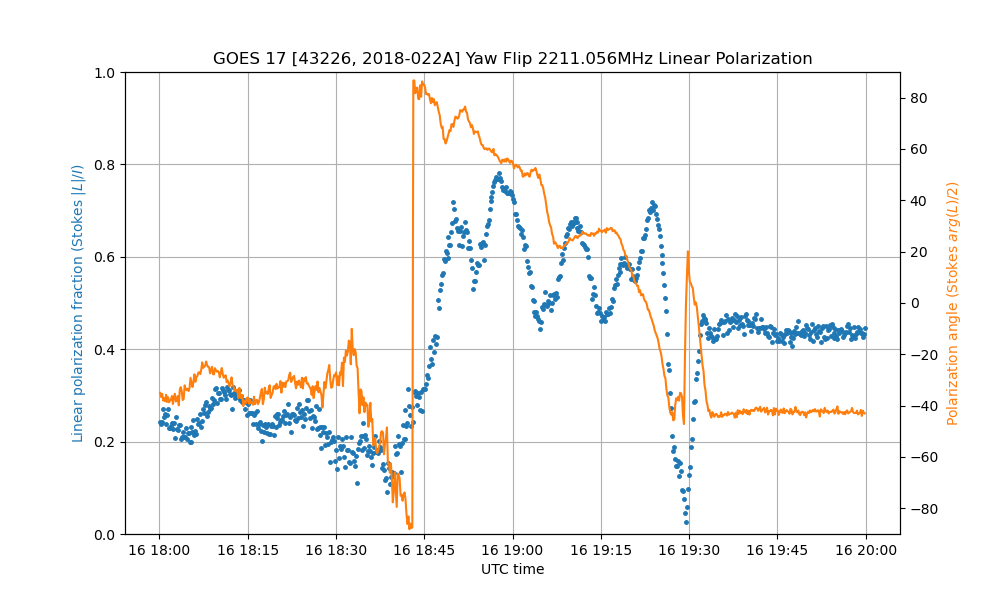
|

Dan Maloney 3:05 PM
What's the furthest satellite that you've bagged so far?
|

Scott Tilley 3:06 PM
Here's some of my latest work. The measurement of the polarization of a satellite is allowing us to see their movements in attitude in space. Here GOES 17 (in storage) undergoes a 180 degree Yaw Flip.
|

Scott Tilley 3:06 PM
bepicolombo as it passed Mercury on X-band using a 66cm dish.
|

Dan Maloney 3:07 PM
Wow, wasn't expecting that at all! Impressive
|

Richard Stanley 3:07 PM
How are you measuring polarization? With two Rx of different polarizations, one V, one H, then compare amplitude?
|

Scott Tilley 3:07 PM
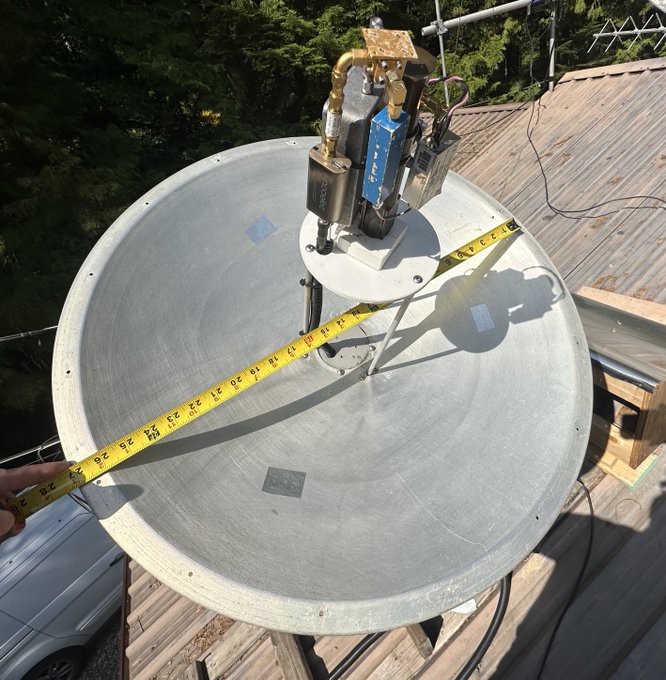
|

Scott Tilley 3:07 PM
This is the MLD (Mighty Little Dish)
|

Scott Tilley 3:08 PM
Yes, I'm using a dual coherent SDR and two preamps on a feed with orthogonal probes.
|

Mark J Hughes 3:09 PM
Scott -- I want to "play" with automatic tracking. Is there an inexpensive way to get a hold of an alt-ele mount? Something that's easy to hack, or something purpose built for tracking I could repurpose?
|

n1sat 3:09 PM
How difficult is it for an amateur to create an accurate TLE of a satellite just from observation?
|

Mark J Hughes 3:09 PM
make that azi-ele
|

Scott Tilley 3:09 PM
I'm presently using used Pelco CCTV mounts. They can sometimes come up on eBay for reasonable prices. The larger units can handle 100lbs+ payloads.
|
|
Thomas Shaddack 3:10 PM
what's the needed positioning accuracy?
|

Scott Tilley 3:11 PM
Making an accurate TLE isn't that hard once you understand how. Optically you need atleast two positions to start to get a orbital estimate. As you gather more data over the arc of the orbit that TLE will get more and more accurate.
|

n1sat 3:11 PM
What toolset do you use to do that? Pen and paper? Python libraries?
|

Dan Maloney 3:11 PM
For the confused: https://en.wikipedia.org/wiki/Two-line_element_set
|

Scott Tilley 3:11 PM
Position accuracy depends on the antenna you want to use. I find 1 degree works fine on S-band with a 1.8m dish.
|

Nate 3:11 PM
not trying to steal Scott's thunder, but rfhamdesign has some relatively inexpensive azel/xy mounts for sale, diy is possible if you can do metalwork
|

Dan Maloney 3:11 PM
I had to look it up ;-)
|

Byron Collie 3:12 PM
I know this is satellite tracking focused but if you don't mind, for your radio astronomy do you look at anything beyond hydrogen line transmission at all? And if so what kind of systems are you using for the observation?
|

Dan Maloney 3:12 PM
The main reflector on the MLD looks like it might have started life as something else...
|

Scott Tilley 3:13 PM
There are a number of tool sets for making TLEs or orbital elements. I have done it on paper but usually use Cees Bassa's sattools tool kit. But there are others
|

JoseSanxez 3:14 PM
Scott, would your polarimetry method also allow for attitude estimation if the target satellite were transmitting the same carrier in two pols (e.g rhcp and lhcp) for robustness reasons?
|

Scott Tilley 3:14 PM
I have done continuum monitoring on S-band of the stronger natural radio sources to calibrate my system. Largely speaking I use the radio system to passively monitor spacecraft emissions to learn about orbits, attitude of spacecraft and record and decode the telemetry.
|

Nate 3:14 PM
for your s-band TT&C observations you post often with STRF, do you typically use an omni type or one of your trackers
|

Nate 3:15 PM
omni type antenna ? and if so is it just a helical type(3-5 turn ?)
|

Scott Tilley 3:15 PM
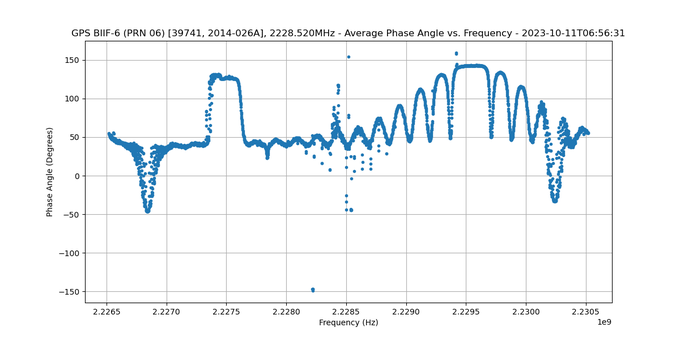
|

Scott Tilley 3:15 PM
If you look at this phase angle plot of a GPS satellite it's showing you that one component of its radio signal is LHCP and the other RHCP.
|

Scott Tilley 3:16 PM
For STRF both omni and tracked antenna. SOmethings parked tracking antenna and just gathering data using the sidebands.
|
|
Keith 3:17 PM
Can you talk about your RF DSP pipeline? What tools do you use for decoding telemetry?
|

Scott Tilley 3:18 PM
I do have a 3.5 turn helix for omni work. But have largely stopped using it. A future experiment will be with a orthogonal waveguide and small horn with a hybird system to improve performance and also allow for polarization switching. As the helix limits you. I recently discovered thart China has an entire network of satellites on S-band using DSSS and LHCP.
|

Richard Stanley 3:19 PM
Can you comment more on how to gather data using sidebands? LEO, MEO, and/or GEO? Does that process involve lots of searching to determine which frequency and thus which satellite?
|

Scott Tilley 3:19 PM
gnuradio for some legacy stuff with the assistance of Daniel Estervez. Presently I actively contribute to the Satdump.org project.
|

Nate 3:20 PM
interesting regarding the Chinese satellites, what part of s-band are they operating at?
|

Scott Tilley 3:20 PM
Yes, search search and search some more. Satellites are in predictable orbits, after you look for awhile you release to search you don't need to search so hard, you point and wait. They will come to you eventually. The secret is patience and a constant gaze.
|

Scott Tilley 3:20 PM
~2243MHz
|

Scott Tilley 3:21 PM
https://twitter.com/i/status/1658281307171065856
|
|
ka9cql 3:22 PM
Do you ever get "requests" from organizations/govts to "please stop talking about X"?
|

Scott Tilley 3:22 PM
Nearly all Chinese government missions use this channel. The bandwidth of the emissions changes
|

Xyzzy 3:22 PM
this is all very interesting. I recently purchased a cheap SDR and have been learning to use it to track air and marine traffic. are there any legal risks involved in tracking these crafts?
|

Scott Tilley 3:22 PM
No, I have never received an invitation to be quiet.
|

Mark J Hughes 3:22 PM
@ka9cql So weird -- I get that from my wife All.the.time. Do you think she secretly works for the government?
|

Xyzzy 3:23 PM
likely
|

Scott Tilley 3:23 PM
I have voluntarily not released information publically when I feel it will negatively impact my nation's and it allies national security.
|

Mark J Hughes 3:23 PM
Okay -- so lets say I go and get a couple motors and rig up an azi-ele mount. How do I control it?
|

Xyzzy 3:23 PM
i heard the glowies regularly hire housewives for long term espionage
|

Scott Tilley 3:24 PM
There are a number of bang bang rotor controllers on the market of DIY systems documented on the web. Use one of those.
|
|
ka9cql 3:24 PM
Is there a good "starter kit" for people that want to play around with satellite reception, or is a "roll-your-own" better, due to things like your own personal interest, what parts you have on hand, etc?
|

Scott Tilley 3:25 PM
Best place to start is the 70cm satellite band. Simple antennas and cheap SDRs work well there and there are lots of signals.
|

Xyzzy 3:26 PM
will that work with this satDump then?
|

Xyzzy 3:26 PM
a rlt sdr?
|
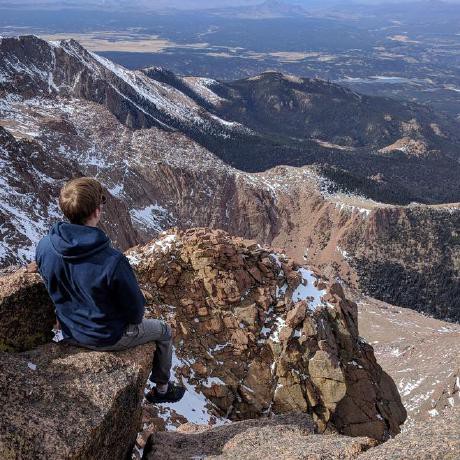
Matthew Phelps 3:26 PM
I assume your SDR has enough bandwidth so no downconversion is needed for S-band?
|

Scott Tilley 3:26 PM
Yes, I use SDRs that cover S-band.
|
|
Thomas Shaddack 3:27 PM
Any filters/preamps?
|

Xyzzy 3:27 PM
what means sband? subhgz?
|

Scott Tilley 3:27 PM
Yes, I use preamps designed for amateur EME work with noise figures around 0.3. Filters optionally as my site is very quiet.
|
|
Thomas Shaddack 3:28 PM
I assume 70cm is about 430 MHz, give or take?
|

Scott Tilley 3:28 PM
S-band is the range of frequencies from 2 - 4 Ghz approximately.
|

Scott Tilley 3:28 PM
Yes on 70cm.
|
|
ka9cql 3:28 PM
What is your "go-to" SDR (presuming you use them)
|

Scott Tilley 3:28 PM
If your interested in 70cm satellites have a look at satnogs.org
|

Xyzzy 3:29 PM
I see. thanks. is there any documentation for a starter setup? maybe a github repo with a collection of information about sat hacking and the needed hardware + software?
|

Scott Tilley 3:30 PM
Have a look at satnogs.org there's lots of info there to get you going in a direction of producing results.
|

Scott Tilley 3:30 PM
And you will be contributing to the overall data collection and monitoring of the band.
|
|
crazytreeboy 3:30 PM
This chat is very informative, but also temporary. Is there an organization you would recommend that can help smooth the learning curve?
|

Dan Maloney 3:31 PM
@crazytreeboy We'll be posting a transcript after the chat, so you'll at least have that to refer back to for links, etc.
|

n1sat 3:31 PM
amsat.org has a lot of info to get started
|

Scott Tilley 3:31 PM
Generally speaking satellite tracking is not a weekend project. If you really go down the rabbit hole you'll need to learn many disciplines. I all depends on what you want to do.
|

Nate 3:32 PM
hearsat / seesat mailing lists (hearsat has a discord)
|

Nate 3:32 PM
do you have any plans to look at higher frequency things, ku,ka
|

Nate 3:33 PM
or any interest in c-band things
|

Matthew Phelps 3:33 PM
Where do you generally like to post your observations?
|

Scott Tilley 3:34 PM
Yes those are good places to start but you may find the discussions there technical and focused on observational programs that may not make a lot of sense over until you really get into it. My suggestion is to visit seesat.org and learn how to obtain satellite observations useful enough to make orbits with binos and a stop watch. What you learn from that will help you truly understand the hobby and you can apply it to everything else. As you will truly understand how orbits work and what your observations are doing.
|

n1sat 3:34 PM
You mentioned that it's possible to optically track satellites. Are most satellites visible at night with the right equipment, like an amateur telescope?
|

Scott Tilley 3:34 PM
I generally micro blog here https://twitter.com/coastal8049
|

Scott Tilley 3:35 PM
I also periodically write up major points of interest here: https://skyriddles.wordpress.com/
|

Scott Tilley 3:35 PM
Many satellites are visible with the naked eye at night.
|

Scott Tilley 3:36 PM
With binos you will be swamped with satellites. You use a time reference and a star chart to time the position of a satellite. Once you have two or more positions timed you can start to work on orbits.
|

Nate 3:36 PM
how rewarding and excited were you when you had picked up on IMAGE, from when you got the first suspicion that it might be something interesting to confirming it?
|

Scott Tilley 3:37 PM
On radio you are interested usually in the Doppler curve. If you fit that curve to a database of known satellites you can find the best match. If you don't get a match you can fit it to a template orbit and obtain a reasonable model of the orbit to find it again and improve it.
|
|
Thomas Shaddack 3:37 PM
Thought. Pair a small telescope/riflescope with a cam with the antenna. (EMI may be a bitch.) Or if the sync is good enough, have two separate azi-ele mounts, one with cam, one with antenna.
|
|
Thomas Shaddack 3:37 PM
Then stars can be used for calibration of the positions, too.
|

Scott Tilley 3:38 PM
RE: IMAGE, At first I wasn't that excited, it was just another HEO object like I had picked up before. It was when I looked up the object and realized it was suppose to be dead that the gravity (pun intended) sunk in.
|

Scott Tilley 3:39 PM
Yes stars are your reference. Did you know that a satellites orbital plane is fixed to the stars?
|

Matthew Phelps 3:39 PM
From the doppler curve, are the quantities used to find the target the relative velocity and elevation angle, both at the TCA?
|

n1sat 3:40 PM
Are there are satellite positions that aren't made publicly available through channels like celestrak or SSN?
|

Scott Tilley 3:41 PM
Like i said on starting out, all the tech isn't helpful. It will just gloss over things and you won't get much understanding from it. It's when you get to the point of doing and learning the basic things like the night sky, understanding the challenges of actual process that you get to a level that the tech becomes helpful to manage the leg work.
|

Scott Tilley 3:42 PM
Yes, classified satellite elements developed by amateur observation are found here: https://www.mmccants.org/
|
|
ka9cql 3:42 PM
Re: "Did you know that a satellites orbital plane is fixed to the stars?" - Could you explain what this means, please?
|

Scott Tilley 3:43 PM
From a Doppler curve one measures the frequency which is related to the line of sight velocity. From there you can compare that to the expected LoS velocity or search for the closest match.
|

Scott Tilley 3:44 PM
https://skyriddles.wordpress.com/2019/01/04/basic-orbital-dynamics/
|

Richard Stanley 3:45 PM
I only found a dead link to the hearsat discord, if anyone can share a new one that would be great.
|
|
Kavitate 3:45 PM
https://discord.com/invite/uq7bkeFBAg
|

Scott Tilley 3:45 PM
Once a satellite is launched into orbit of say the earth it's orbital plane is fixed with respect to the stars. Imagine the celestial sphere (the stars) surrounding us. That orbit stays fixed to that geometry. We rotate under that sphere.
|

Richard Stanley 3:45 PM
thanks @Kavitate
|

Scott Tilley 3:45 PM
Hearsat is largely unused.
|

Scott Tilley 3:47 PM
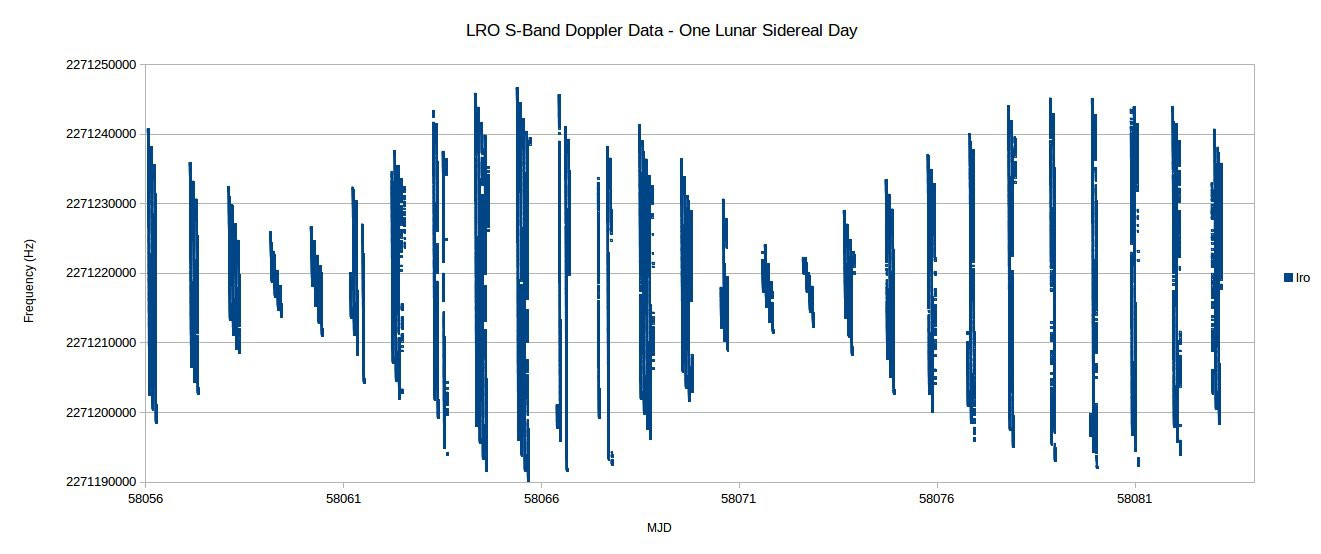
|
Hack Chat Transcript, Page 1
A event log for Satellite Hunting Hack Chat
What's really going on up there?
 Tom Nardi
Tom Nardi
Discussions
Become a Hackaday.io Member
Create an account to leave a comment. Already have an account? Log In.